Nong Sang
VideoLucy: Deep Memory Backtracking for Long Video Understanding
Oct 14, 2025Abstract:Recent studies have shown that agent-based systems leveraging large language models (LLMs) for key information retrieval and integration have emerged as a promising approach for long video understanding. However, these systems face two major challenges. First, they typically perform modeling and reasoning on individual frames, struggling to capture the temporal context of consecutive frames. Second, to reduce the cost of dense frame-level captioning, they adopt sparse frame sampling, which risks discarding crucial information. To overcome these limitations, we propose VideoLucy, a deep memory backtracking framework for long video understanding. Inspired by the human recollection process from coarse to fine, VideoLucy employs a hierarchical memory structure with progressive granularity. This structure explicitly defines the detail level and temporal scope of memory at different hierarchical depths. Through an agent-based iterative backtracking mechanism, VideoLucy systematically mines video-wide, question-relevant deep memories until sufficient information is gathered to provide a confident answer. This design enables effective temporal understanding of consecutive frames while preserving critical details. In addition, we introduce EgoMem, a new benchmark for long video understanding. EgoMem is designed to comprehensively evaluate a model's ability to understand complex events that unfold over time and capture fine-grained details in extremely long videos. Extensive experiments demonstrate the superiority of VideoLucy. Built on open-source models, VideoLucy significantly outperforms state-of-the-art methods on multiple long video understanding benchmarks, achieving performance even surpassing the latest proprietary models such as GPT-4o. Our code and dataset will be made publicly at https://videolucy.github.io
Learning Unpaired Image Dehazing with Physics-based Rehazy Generation
Jun 15, 2025Abstract:Overfitting to synthetic training pairs remains a critical challenge in image dehazing, leading to poor generalization capability to real-world scenarios. To address this issue, existing approaches utilize unpaired realistic data for training, employing CycleGAN or contrastive learning frameworks. Despite their progress, these methods often suffer from training instability, resulting in limited dehazing performance. In this paper, we propose a novel training strategy for unpaired image dehazing, termed Rehazy, to improve both dehazing performance and training stability. This strategy explores the consistency of the underlying clean images across hazy images and utilizes hazy-rehazy pairs for effective learning of real haze characteristics. To favorably construct hazy-rehazy pairs, we develop a physics-based rehazy generation pipeline, which is theoretically validated to reliably produce high-quality rehazy images. Additionally, leveraging the rehazy strategy, we introduce a dual-branch framework for dehazing network training, where a clean branch provides a basic dehazing capability in a synthetic manner, and a hazy branch enhances the generalization ability with hazy-rehazy pairs. Moreover, we design a new dehazing network within these branches to improve the efficiency, which progressively restores clean scenes from coarse to fine. Extensive experiments on four benchmarks demonstrate the superior performance of our approach, exceeding the previous state-of-the-art methods by 3.58 dB on the SOTS-Indoor dataset and by 1.85 dB on the SOTS-Outdoor dataset in PSNR. Our code will be publicly available.
ReID5o: Achieving Omni Multi-modal Person Re-identification in a Single Model
Jun 11, 2025Abstract:In real-word scenarios, person re-identification (ReID) expects to identify a person-of-interest via the descriptive query, regardless of whether the query is a single modality or a combination of multiple modalities. However, existing methods and datasets remain constrained to limited modalities, failing to meet this requirement. Therefore, we investigate a new challenging problem called Omni Multi-modal Person Re-identification (OM-ReID), which aims to achieve effective retrieval with varying multi-modal queries. To address dataset scarcity, we construct ORBench, the first high-quality multi-modal dataset comprising 1,000 unique identities across five modalities: RGB, infrared, color pencil, sketch, and textual description. This dataset also has significant superiority in terms of diversity, such as the painting perspectives and textual information. It could serve as an ideal platform for follow-up investigations in OM-ReID. Moreover, we propose ReID5o, a novel multi-modal learning framework for person ReID. It enables synergistic fusion and cross-modal alignment of arbitrary modality combinations in a single model, with a unified encoding and multi-expert routing mechanism proposed. Extensive experiments verify the advancement and practicality of our ORBench. A wide range of possible models have been evaluated and compared on it, and our proposed ReID5o model gives the best performance. The dataset and code will be made publicly available at https://github.com/Zplusdragon/ReID5o_ORBench.
MP-Mat: A 3D-and-Instance-Aware Human Matting and Editing Framework with Multiplane Representation
Apr 20, 2025



Abstract:Human instance matting aims to estimate an alpha matte for each human instance in an image, which is challenging as it easily fails in complex cases requiring disentangling mingled pixels belonging to multiple instances along hairy and thin boundary structures. In this work, we address this by introducing MP-Mat, a novel 3D-and-instance-aware matting framework with multiplane representation, where the multiplane concept is designed from two different perspectives: scene geometry level and instance level. Specifically, we first build feature-level multiplane representations to split the scene into multiple planes based on depth differences. This approach makes the scene representation 3D-aware, and can serve as an effective clue for splitting instances in different 3D positions, thereby improving interpretability and boundary handling ability especially in occlusion areas. Then, we introduce another multiplane representation that splits the scene in an instance-level perspective, and represents each instance with both matte and color. We also treat background as a special instance, which is often overlooked by existing methods. Such an instance-level representation facilitates both foreground and background content awareness, and is useful for other down-stream tasks like image editing. Once built, the representation can be reused to realize controllable instance-level image editing with high efficiency. Extensive experiments validate the clear advantage of MP-Mat in matting task. We also demonstrate its superiority in image editing tasks, an area under-explored by existing matting-focused methods, where our approach under zero-shot inference even outperforms trained specialized image editing techniques by large margins. Code is open-sourced at https://github.com/JiaoSiyi/MPMat.git}.
Taming Consistency Distillation for Accelerated Human Image Animation
Apr 15, 2025Abstract:Recent advancements in human image animation have been propelled by video diffusion models, yet their reliance on numerous iterative denoising steps results in high inference costs and slow speeds. An intuitive solution involves adopting consistency models, which serve as an effective acceleration paradigm through consistency distillation. However, simply employing this strategy in human image animation often leads to quality decline, including visual blurring, motion degradation, and facial distortion, particularly in dynamic regions. In this paper, we propose the DanceLCM approach complemented by several enhancements to improve visual quality and motion continuity at low-step regime: (1) segmented consistency distillation with an auxiliary light-weight head to incorporate supervision from real video latents, mitigating cumulative errors resulting from single full-trajectory generation; (2) a motion-focused loss to centre on motion regions, and explicit injection of facial fidelity features to improve face authenticity. Extensive qualitative and quantitative experiments demonstrate that DanceLCM achieves results comparable to state-of-the-art video diffusion models with a mere 2-4 inference steps, significantly reducing the inference burden without compromising video quality. The code and models will be made publicly available.
UniAnimate-DiT: Human Image Animation with Large-Scale Video Diffusion Transformer
Apr 15, 2025Abstract:This report presents UniAnimate-DiT, an advanced project that leverages the cutting-edge and powerful capabilities of the open-source Wan2.1 model for consistent human image animation. Specifically, to preserve the robust generative capabilities of the original Wan2.1 model, we implement Low-Rank Adaptation (LoRA) technique to fine-tune a minimal set of parameters, significantly reducing training memory overhead. A lightweight pose encoder consisting of multiple stacked 3D convolutional layers is designed to encode motion information of driving poses. Furthermore, we adopt a simple concatenation operation to integrate the reference appearance into the model and incorporate the pose information of the reference image for enhanced pose alignment. Experimental results show that our approach achieves visually appearing and temporally consistent high-fidelity animations. Trained on 480p (832x480) videos, UniAnimate-DiT demonstrates strong generalization capabilities to seamlessly upscale to 720P (1280x720) during inference. The training and inference code is publicly available at https://github.com/ali-vilab/UniAnimate-DiT.
DMPT: Decoupled Modality-aware Prompt Tuning for Multi-modal Object Re-identification
Apr 15, 2025Abstract:Current multi-modal object re-identification approaches based on large-scale pre-trained backbones (i.e., ViT) have displayed remarkable progress and achieved excellent performance. However, these methods usually adopt the standard full fine-tuning paradigm, which requires the optimization of considerable backbone parameters, causing extensive computational and storage requirements. In this work, we propose an efficient prompt-tuning framework tailored for multi-modal object re-identification, dubbed DMPT, which freezes the main backbone and only optimizes several newly added decoupled modality-aware parameters. Specifically, we explicitly decouple the visual prompts into modality-specific prompts which leverage prior modality knowledge from a powerful text encoder and modality-independent semantic prompts which extract semantic information from multi-modal inputs, such as visible, near-infrared, and thermal-infrared. Built upon the extracted features, we further design a Prompt Inverse Bind (PromptIBind) strategy that employs bind prompts as a medium to connect the semantic prompt tokens of different modalities and facilitates the exchange of complementary multi-modal information, boosting final re-identification results. Experimental results on multiple common benchmarks demonstrate that our DMPT can achieve competitive results to existing state-of-the-art methods while requiring only 6.5% fine-tuning of the backbone parameters.
NTIRE 2025 Challenge on Cross-Domain Few-Shot Object Detection: Methods and Results
Apr 14, 2025Abstract:Cross-Domain Few-Shot Object Detection (CD-FSOD) poses significant challenges to existing object detection and few-shot detection models when applied across domains. In conjunction with NTIRE 2025, we organized the 1st CD-FSOD Challenge, aiming to advance the performance of current object detectors on entirely novel target domains with only limited labeled data. The challenge attracted 152 registered participants, received submissions from 42 teams, and concluded with 13 teams making valid final submissions. Participants approached the task from diverse perspectives, proposing novel models that achieved new state-of-the-art (SOTA) results under both open-source and closed-source settings. In this report, we present an overview of the 1st NTIRE 2025 CD-FSOD Challenge, highlighting the proposed solutions and summarizing the results submitted by the participants.
Exploring the Evolution of Physics Cognition in Video Generation: A Survey
Mar 27, 2025Abstract:Recent advancements in video generation have witnessed significant progress, especially with the rapid advancement of diffusion models. Despite this, their deficiencies in physical cognition have gradually received widespread attention - generated content often violates the fundamental laws of physics, falling into the dilemma of ''visual realism but physical absurdity". Researchers began to increasingly recognize the importance of physical fidelity in video generation and attempted to integrate heuristic physical cognition such as motion representations and physical knowledge into generative systems to simulate real-world dynamic scenarios. Considering the lack of a systematic overview in this field, this survey aims to provide a comprehensive summary of architecture designs and their applications to fill this gap. Specifically, we discuss and organize the evolutionary process of physical cognition in video generation from a cognitive science perspective, while proposing a three-tier taxonomy: 1) basic schema perception for generation, 2) passive cognition of physical knowledge for generation, and 3) active cognition for world simulation, encompassing state-of-the-art methods, classical paradigms, and benchmarks. Subsequently, we emphasize the inherent key challenges in this domain and delineate potential pathways for future research, contributing to advancing the frontiers of discussion in both academia and industry. Through structured review and interdisciplinary analysis, this survey aims to provide directional guidance for developing interpretable, controllable, and physically consistent video generation paradigms, thereby propelling generative models from the stage of ''visual mimicry'' towards a new phase of ''human-like physical comprehension''.
FedPCA: Noise-Robust Fair Federated Learning via Performance-Capacity Analysis
Mar 13, 2025



Abstract:Training a model that effectively handles both common and rare data-i.e., achieving performance fairness-is crucial in federated learning (FL). While existing fair FL methods have shown effectiveness, they remain vulnerable to mislabeled data. Ensuring robustness in fair FL is therefore essential. However, fairness and robustness inherently compete, which causes robust strategies to hinder fairness. In this paper, we attribute this competition to the homogeneity in loss patterns exhibited by rare and mislabeled data clients, preventing existing loss-based fair and robust FL methods from effectively distinguishing and handling these two distinct client types. To address this, we propose performance-capacity analysis, which jointly considers model performance on each client and its capacity to handle the dataset, measured by loss and a newly introduced feature dispersion score. This allows mislabeled clients to be identified by their significantly deviated performance relative to capacity while preserving rare data clients. Building on this, we introduce FedPCA, an FL method that robustly achieves fairness. FedPCA first identifies mislabeled clients via a Gaussian Mixture Model on loss-dispersion pairs, then applies fairness and robustness strategies in global aggregation and local training by adjusting client weights and selectively using reliable data. Extensive experiments on three datasets demonstrate FedPCA's effectiveness in tackling this complex challenge. Code will be publicly available upon acceptance.
 Add to Chrome
Add to Chrome Add to Firefox
Add to Firefox Add to Edge
Add to Edge